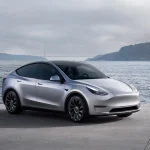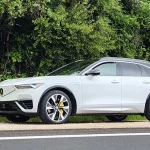
(Reverse) Engineering Explained: What happens to old electric car batteries?(Reverse) Engineering Explained: What happens to old electric car batteries?
Reduce, reuse, recycle.
It’s the same philosophy for electric-car batteries as for plastic grocery bags—almost.
Knowing what happens to lithium-ion batteries from phones, cameras, and other electronic devices, many electric-car critics express a reasonable concern about what might happen to the similar batteries on a much larger scale that power electric cars.
DON’T MISS: As used electric-car batteries set to flood market, Automakers ramp up reuse efforts
Jason Fenske, a mechanical engineering graduate from North Carolina State University, who runs a series of videos on YouTube that we’ve covered before, addresses the question in one of his latest videos. Fenske usually sticks to explaining—in minute detail—the inner workings of gas engines, often with an engineer’s eye toward improving efficiency.
It’s refreshing to see the series turn optimistically toward examining electric cars. And Fenske is optimistic about the disposition of used electric-car batteries.
It turns out, their very size is one of the main benefits that will prevent electric car batteries from clogging landfills.
Nissan Leaf battery
Unlike used camera batteries that can fit in a pocket, it takes heavy equipment—multiple lifts that can each handle thousands of pounds—to remove a battery from an electric-car. For the most part, only car dealers and a few mechanics have the capability to swap electric car batteries.
Automakers in China are responsible for ensuring that spent packs from their cars don’t end up in landfills, and similar laws are expected to be passed in Europe and the U.S.
As automakers build more electric cars with longer ranges, reducing battery use is not the model for electric-car batteries.
2018 Nissan Leaf SL
Instead, automakers are ramping up reuse efforts that can extend the lives of electric-car battery packs, such as reselling them as stationary power packs for projects such as street lights (in Japan), an island (in Portugal), and homes.
A 30-kilowatt-hour battery pack from a Nissan Leaf can power an ordinary house for more than a day when emergency power is needed. Nissan has opened a battery recycling facility in Japan and is studying opening one in the U.S.
CHECK OUT: Engineers find new ways to improve efficiency of gas engines: Engineering Explained
When asked if batteries in the Nissan Leaf can be fully recycled, Nissan electric-car spokesman Jeff Wandell told Engineering Explained: “Generally yes. The pack components consist of steel, copper, aluminum, and some plastic. The cells can be recycled via different methods to recover the cobalt, nickel, manganese, and lithium mixtures. The recovered materials are refined to necessary purities for re-use in general industry and potentially also for manufacturing new battery cells.”
READ MORE: Nissan begins offering rebuilt Leaf battery packs
Recycling is the final effort.
The lithium batteries in modern electric cars such as the Leaf generally contain only 5 to 7 percent lithium, 5 to 20 percent cobalt, and 5 to 10 percent nickel, all of which are commercially recycled.
So far the problem’s scope is limited, because relatively few electric cars are reaching the end of their battery life. Last year, according to a Bloomberg report, 55,000 batteries were removed from electric cars. In the next five years, that number is expected to skyrocket to 3.4 million battery packs.
So far, it is cheaper for automakers to buy new battery materials than to recycle old ones. Only getting more electric cars on the roads is likely to change that over time.
View original article at: “https://www.greencarreports.com//news/1118883_reverse-engineering-explained-what-happens-to-old-electric-car-batteries”
Add a comment Cancel reply
Comments (0)
ข่าวบอล
… [Trackback]
[…] Find More here on that Topic: autoseu.com/reverse-engineering-explained-what-happens-to-old-electric-car-batteriesreverse-engineering-explained-what-happens-to-old-electric-car-batteries/ […]
Dnabet.com
… [Trackback]
[…] Find More on on that Topic: autoseu.com/reverse-engineering-explained-what-happens-to-old-electric-car-batteriesreverse-engineering-explained-what-happens-to-old-electric-car-batteries/ […]
what do you normally order mushrooms
… [Trackback]
[…] Find More Info here to that Topic: autoseu.com/reverse-engineering-explained-what-happens-to-old-electric-car-batteriesreverse-engineering-explained-what-happens-to-old-electric-car-batteries/ […]
check this link right here now
… [Trackback]
[…] Find More Info here on that Topic: autoseu.com/reverse-engineering-explained-what-happens-to-old-electric-car-batteriesreverse-engineering-explained-what-happens-to-old-electric-car-batteries/ […]
Categories
- Activism (1)
- Adventure (1)
- Advertising (2)
- Agriculture (1)
- Air pollution (4)
- Air transport (3)
- aluminium (2)
- Amazon (3)
- Animals (1)
- Apple (2)
- Architecture (1)
- Arctic (1)
- Artificial intelligence (1)
- Augmented Reality (1)
- Auto Detailing (1)
- autopilot (1)
- battery (31)
- Best summer holiday destinations 2022 (1)
- Bicycle (1)
- biodiversity (1)
- BMW (2)
- boat (1)
- Bus (1)
- Business (4)
- Buying Guides (1)
- car (7)
- Car industry (18)
- Car News (18)
- car rental (3)
- Car Reviews (4)
- Car sales (6)
- carbon emissions (15)
- carbon footprint (3)
- Carlos Ghosn (1)
- Cars (66)
- Central Europe (1)
- CES (2)
- charging station (11)
- Children (1)
- China (12)
- Citroën (1)
- city (1)
- City transport network (2)
- clean energy (2)
- Climate (1)
- climate change (9)
- Climate crisis (4)
- Climate emergency (2)
- climate protection (2)
- CO2 emissions (39)
- Company (3)
- Competition (1)
- Conscious travel (2)
- Contamination of water (1)
- Copper (2)
- cost of living (2)
- Cuba (1)
- Cuban politics (1)
- Cybertruck (1)
- Cycling (1)
- deforestation (1)
- delivery (3)
- Denmark (2)
- Detroit (1)
- Diesel (4)
- Diesel car (7)
- e-mobility (11)
- e-scooter (2)
- Eco travel (3)
- Eco-friendly (2)
- Ecology (1)
- Economy (1)
- El Niño (1)
- Electric (11,302)
- Electric boats (1)
- electric car (107)
- Electric Cars (499)
- Electricity (5)
- Electricity consumption (3)
- Electricity market (5)
- Elon Musk (21)
- emission (1)
- Emmanuel Macron (1)
- Energy (2)
- Energy low cost (1)
- energy transition (6)
- Entrepreneur (1)
- Environment (5)
- Environment pollution (1)
- Environmental protection (4)
- EU Policy (1)
- EU-China (2)
- Europe (7)
- Europe's energy crisis (1)
- European Commission (3)
- European economy (2)
- European Union (18)
- Euroviews (6)
- Eviction (1)
- EVs (37)
- F1 (1)
- factory (4)
- fake news (1)
- family (2)
- Ferrari (1)
- fertilizer (1)
- fine (penalty) (1)
- fire station service (1)
- flight (1)
- Flying car (4)
- Food security (1)
- Ford (1)
- Formula 1 (2)
- Fossil fuels (14)
- France (39)
- free trade (1)
- Fuel (3)
- Fuel cell electric vehicles FCEV (10)
- fuel crisis (2)
- Fuel Efficiency (3)
- fuel prices (1)
- Funeral (1)
- Gas (1)
- Gas Prices (1)
- gasoline price hike (1)
- German (1)
- Germany (8)
- Giorgia Meloni (1)
- Global warming and climate change (1)
- Good News (1)
- Greece (1)
- green energy (1)
- green new deal (1)
- Green transportation (17)
- Green Week (1)
- greenhouse gas emissions (6)
- Hanoi (19)
- Health (1)
- home (2)
- homelessness (1)
- Housing market (19)
- human rights abuse (1)
- Hybrid (2,283)
- Hybrids (116)
- Hydrogen (2)
- hydrogen vehicle (2)
- IAA Mobility (2)
- Iceland (3)
- incident (1)
- income (1)
- India (2)
- Indonesia (1)
- infrastructure (1)
- innovation (1)
- International relations (1)
- Investment (4)
- iPhone (1)
- Japan (1)
- Jobs (3)
- Joe Biden (4)
- Jubilee (1)
- Lampedusa (1)
- Las Vegas (1)
- lead petrol (2)
- Lithium (13)
- liveable cities (2)
- London (3)
- Luxembourg (1)
- Luxury (2)
- luxury goods (2)
- Luxury lifestyle (2)
- Manufacturing (5)
- Market (1)
- Markets (1)
- meat (1)
- Mercedes-Benz (39)
- Migrants (1)
- minerals (2)
- Mining (5)
- Mitsubishi Motors (1)
- Mobile World Congress (1)
- Mobility (10)
- Mobility Week (2)
- Mobility Week 2021 (1)
- Mobility Week 2023 (5)
- money (3)
- Motorcycling (2)
- Motorsport (1)
- Mountain (1)
- NASA (1)
- nature (2)
- net-zero (2)
- New technologies (6)
- Next Explainers (1)
- Next In data (2)
- Nigeria (1)
- Nissan (3)
- Norway (7)
- Nuclear Energy (1)
- nuclear fusion (1)
- Nuclear power plant (1)
- Odd (1)
- oil industry (1)
- Olaf Scholz (1)
- online shopping (1)
- Oslo (1)
- Paris (1)
- parody (1)
- Petroleum products (3)
- Peugeot (1)
- plastic (1)
- Poland (1)
- Politics (1)
- Pollution (44)
- Power Plant (1)
- prices (1)
- production (1)
- Profits (1)
- Prostitution (1)
- Public transport (4)
- Racing cars (1)
- Racism (1)
- Rail transport (2)
- rats (1)
- Raw material (1)
- Recycling (4)
- Renault (3)
- Renewable energies (6)
- renewable energy (6)
- Reykjavík (1)
- Rishi Sunak (1)
- road (36)
- Road infrastructures (1)
- Road safety (7)
- Road transport (20)
- road trip (1)
- Robot (1)
- Rolls Royce (1)
- Russia (1)
- Russia's invasion of Ukraine (2)
- Sadiq Khan (1)
- safari (1)
- Safety (1)
- Sale (1)
- sales (3)
- Scotland (1)
- self-driving (43)
- Semiconductor (1)
- Shares (1)
- Show (1)
- Silicone (1)
- Software (1)
- Solar energy (2)
- solar power (5)
- Space technology (1)
- Spain (1)
- start-up (3)
- Stock exchange transaction (1)
- Stock market activity (1)
- Stockholm (1)
- Strasbourg (1)
- Students (1)
- Summer Olympics (2)
- Sustainability (7)
- Sustainable city (3)
- Sustainable design (3)
- Sustainable development (1)
- Sustainable innovation (9)
- Sustainable technology (21)
- Sustainable tourism (4)
- Sweden (2)
- Tata Motors (2)
- Tax (37)
- Taxes (2)
- Taxi (1)
- Technology (55)
- Tesla (73)
- The Boring company (1)
- Tokyo Olympic Games 2020 (1)
- Toyota (4)
- trade (3)
- traffic (1)
- Trains (2)
- Transport (11)
- transportation (3)
- Travel destinations (1)
- Tunnel (1)
- Twitter (3)
- UBER (1)
- Ukraine war (1)
- Uncategorized (6)
- United Kingdom (5)
- United States (6)
- urban planning (2)
- Ursula von der Leyen (3)
- US politics (1)
- USA (1)
- vegan (1)
- vehicle (7)
- Video (4)
- Vietnam (19)
- Volkswagen (3)
- Volvo (2)
- waste (1)
- waste disposal (1)
- Water (1)
- Water resources (1)
- White House (1)
- wind energy (1)
- Wind turbine (1)
- Winter (2)
- work conditions (1)
- World Travel Market (1)
- Xiaomi (1)
Recent Posts
About us

Popular Tags
Related posts


Volvo EX30 in the test: Really a premium car at a volume price?

VW ID.7: Estate is not called Variant... It's a Tourer







